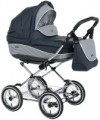Frame material
The main material from which the frame of the pushchair is made.
— Aluminium. The material used in the vast majority of modern pushchairs of all price categories. This is due to a number of advantages: aluminium is light and at the same time durable, it does not rust and is not afraid of moisture, it lasts a long time, it looks nice, but it is relatively inexpensive — somewhat more expensive than steel, but noticeably cheaper than more advanced materials like carbon.
— Steel. Steel frames are as strong as aluminium frames, and they are much cheaper. On the other hand, they are quite heavy, so steel is used less often in pushchairs.
— Magnesium alloy. Premium Material: Stronger and more durable than aluminium, just as lightweight, but at a significantly higher cost. It is extremely rare, in single models of expensive pushchairs.
— Carbon. Another high-end material: carbon fiber filled with plastic. This combination gives excellent strength - comparable to steel — at a very low weight. However, carbon is very expensive, and these advantages are rarely decisive for pushchairs — in most cases simpler materials are enough. That is why carbon frames have not become widespread.
— Plastic. Plastic itself is easy to manufacture and relatively cheap; it is also not as cold to the hands in cool weather as aluminium or steel. However, modern pushchairs very rarely have frames made of this material. The fact is that low-cost vari...eties of plastic are not strong enough for this; and high-quality varieties cost accordingly - their price is close to aluminium, or even higher.
— Fibreglass. In this context, "fibreglass" typically refers to glass fibers mixed with plastic filler. Unlike conventional window glass, glass fibers are flexible and strong. The plastic filler enhances durability by offering scratch and tear resistance. The result is a material that is lightweight and very strong. However, fibreglass is prone to brittleness, especially with point impacts, and is susceptible to abrasion. As a result, it isn't widely used in pushchairs.
Carrycot dimensions (LxW)
Dimensions of the carrycot provided in the kit.
Partly the rule "the bigger the better" works here: a large carrycot gives a good reserve for the period of growth of the baby, in winter you can put the baby dressed in warm clothes in it, and in summer the extra space in the carrycot provides good ventilation. On the other hand, large carrycots are more bulky, weigh more and cost more.

